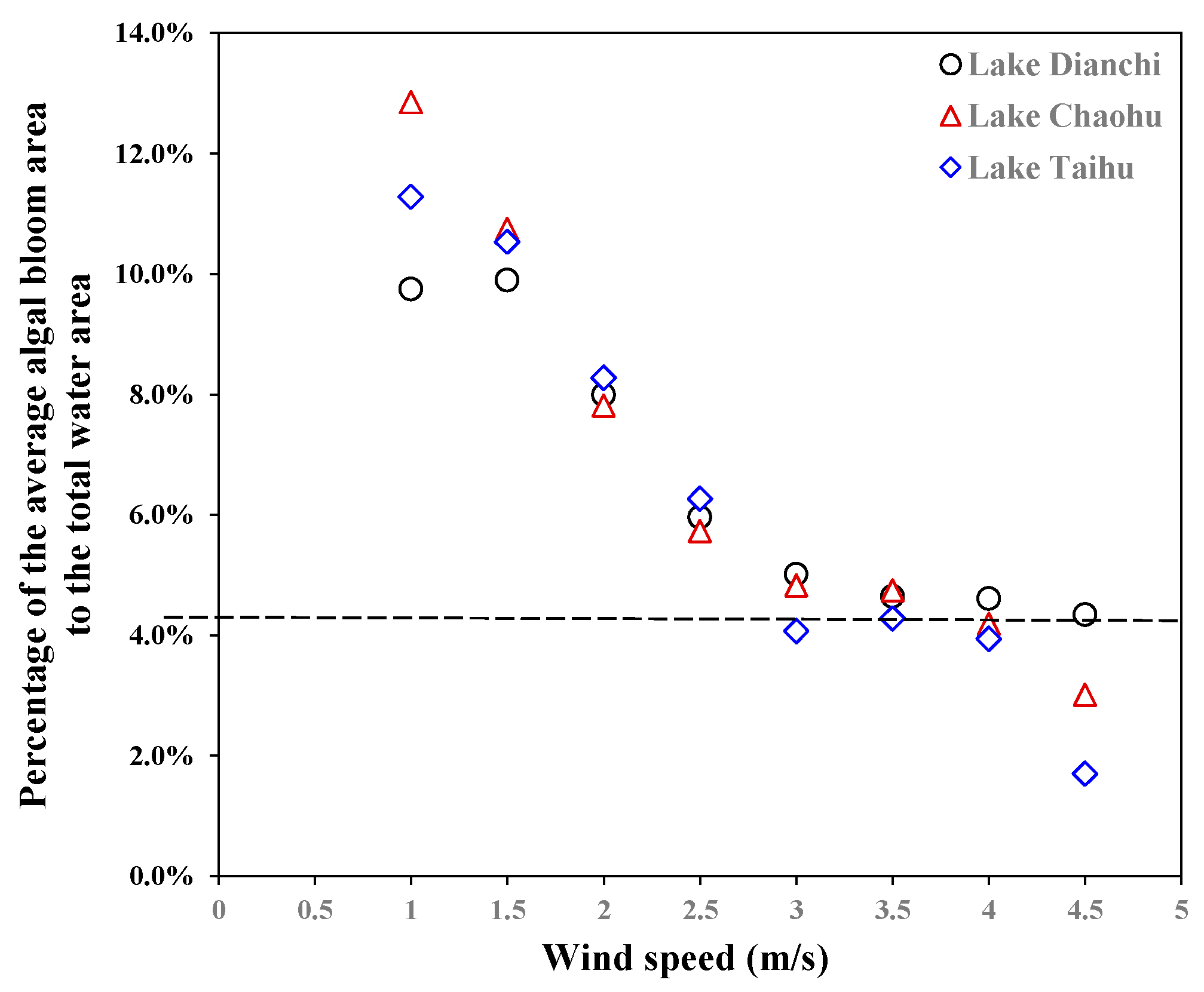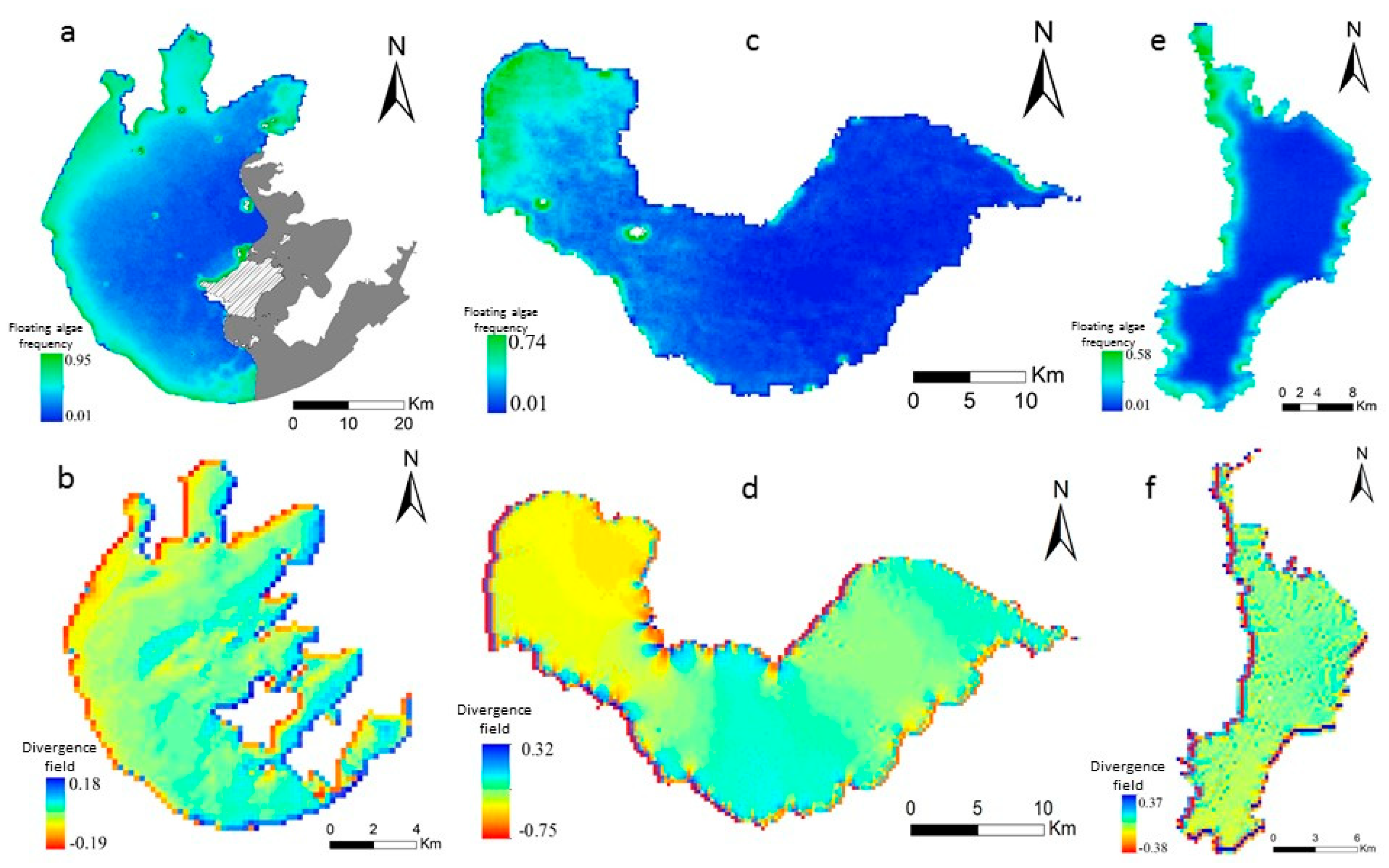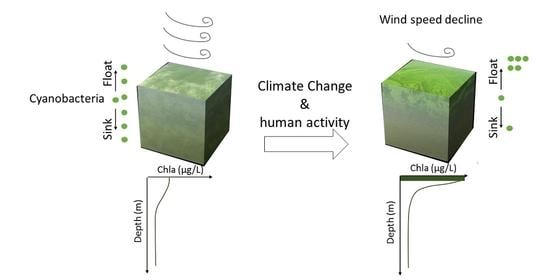Wind Effects for Floating Algae Dynamics in Eutrophic Lakes
Abstract
:1. Introduction
2. Data and Methods
2.1. Algal Bloom Monitoring
2.2. Wind Dynamics
2.3. Long Term and Seasonal Trends Analysis
3. Results
4. Discussion
4.1. Wind Speed Effect on the Seasonal Cycle of Floating Algal Blooms
4.2. Wind Direction Effects on the Spatial Distribution of Floating Algae Blooms
4.3. Implications for Administrators
5. Conclusions
Author Contributions
Funding
Acknowledgments
Conflicts of Interest
References
- Huisman, J.; Matthijs, H.C.P.; Visser, P.M.E. Harmful Cyanobacteria; Springer: Dordrecht, The Netherlands, 2005. [Google Scholar]
- Paerl, H.W.; Hall, N.S.; Calandrino, E.S. Controlling harmful cyanobacterial blooms in a world experiencing anthropogenic and climatic-induced change. Sci. Total Environ. 2011, 409, 1739–1745. [Google Scholar] [CrossRef] [PubMed]
- Shi, K.; Zhang, Y.; Zhang, Y.; Li, N.; Qin, B.; Zhu, G.; Zhou, Y. Phenology of phytoplankton blooms in a trophic lake observed from long-term MODIS data. Environ. Sci. Technol. 2019, 53, 2324–2331. [Google Scholar] [CrossRef]
- Beniston, M.; Stephenson, D.B.; Christensen, O.B.; Ferro, C.A.T.; Frei, C.; Goyette, S.; Halsnaes, K.; Holt, T.; Jylhä, K.; Koffi, B.; et al. Future extreme events in european climate: An exploration of regional climate model projections. Clim. Chang. 2007, 81, 71–95. [Google Scholar] [CrossRef] [Green Version]
- Vincon-Leite, B.; Casenave, C. Modelling eutrophication in lake ecosystems: A review. Sci. Total Environ. 2019, 651, 2985–3001. [Google Scholar] [CrossRef]
- Coats, R.; Perez-Losada, J.; Schladow, G.; Richards, R.; Goldman, C. The warming of Lake Tahoe. Clim. Chang. 2006, 76, 121–148. [Google Scholar] [CrossRef]
- Stainsby, E.; Winter, J.; Jarjanazi, H.; Paterson, A.; Evans, D.; Young, J. Changes in the thermal stability of Lake Simcoe from 1980 to 2008. J. Great Lakes Res. 2011, 37, 55–62. [Google Scholar] [CrossRef]
- Winder, M.; Schindler, D.E. Climate change uncouples trophic interactions in an aquatic ecosystem. Ecology 2004, 85, 2100–2106. [Google Scholar] [CrossRef]
- Guo, H.; Xu, M.; Hu, Q. Changes in near-surface wind speed in China: 1969–2005. Int. J. Climatol. 2011, 31, 349–358. [Google Scholar] [CrossRef]
- Zhang, Y.; Wu, Z.; Liu, M.; He, J.; Shi, K.; Zhou, Y.; Wang, M.; Liu, X. Dissolved oxygen stratification and response to thermal structure and long-term climate change in a large and deep subtropical reservoir (Lake Qiandaohu, China). Water Res. 2015, 75, 249–258. [Google Scholar] [CrossRef] [PubMed]
- Zhang, Y.; Wu, Z.; Liu, M.; He, J.; Shi, K.; Wang, M.; Yu, Z. Thermal structure and response to long-term climatic changes in Lake Qiandaohu, a deep subtropical reservoir in China. Limnol. Oceanogr. 2014, 59, 1193–1202. [Google Scholar] [CrossRef]
- Yoshimizu, C.; Yoshiyama, K.; Tayasu, I.; Koitabashi, T.; Nagata, T. Vulnerability of a large monomictic lake (Lake Biwa) to warm winter event. Limnology 2010, 11, 233–239. [Google Scholar] [CrossRef]
- Zhou, Y.; Obenour, D.R.; Scavia, D.; Johengen, T.H.; Michalak, A.M. Spatial and temporal trends in Lake Erie hypoxia, 1987–2007. Environ. Sci. Technol. 2013, 47, 899–905. [Google Scholar] [CrossRef] [PubMed]
- Cao, H.; Kong, F.; Luo, L.; Shi, X.; Yang, Z.; Zhang, X.; Tao, Y. Effects of wind and wind-induced waves on vertical phytoplankton distribution and surface blooms of Microcystis aeruginosa in Lake Taihu. J. Freshw. Ecol. 2006, 21, 231–238. [Google Scholar] [CrossRef]
- Xue, K.; Zhang, Y.; Duan, H.; Ma, R.; Loiselle, S.; Zhang, M. A remote sensing approach to estimate vertical profile classes of phytoplankton in a eutrophic lake. Remote Sens. 2015, 7, 14403–14427. [Google Scholar] [CrossRef] [Green Version]
- Zhang, Y.; Ma, R.; Duan, H.; Loiselle, S.; Xu, J. Satellite analysis to identify changes and drivers of CyanoHABs dynamics in lake Taihu. Water Sci. Technol. Water Supply 2016, 16, 1451–1466. [Google Scholar] [CrossRef]
- Zhang, Y.; Ma, R.; Duan, H.; Loiselle, S.A.; Xu, J.; Ma, M. A novel algorithm to estimate algal bloom coverage to subpixel resolution in Lake Taihu. IEEE J. Sel. Top. Appl. Earth Obs. Remote Sens. 2014, 7, 3060–3068. [Google Scholar] [CrossRef]
- Zhang, Y.; Ma, R.; Duan, H.; Loiselle, S.; Zhang, M.; Xu, J. A novel MODIS algorithm to estimate chlorophyll a concentration in eutrophic turbid lakes. Ecol. Indic. 2016, 69, 138–151. [Google Scholar] [CrossRef]
- He, Y.; Xiong, Q.; Luo, X.; Li, T.; Yu, L. Study on spatio-temporal changes of water bloom in Dianchi Lake based on NDVI. Ecol. Environ. Sci. 2019, 28, 555–563, (In Chinese with English Abstract). [Google Scholar]
- Zhang, M.; Yang, Z.; Yu, Y.; Shi, X. Interannual and seasonal shift between Microcystis and Dolichospermum: A 7-year investigation in Lake Chaohu, China. Water 2020, 12, 1978. [Google Scholar] [CrossRef]
- Shan, K.; Song, L.; Chen, W.; Li, L.; Liu, L.; Wu, Y.; Jia, Y.; Zhou, Q.; Peng, L. Analysis of environmental drivers influencing interspecific variations and associations among bloom-forming cyanobacteria in large, shallow eutrophic lakes. Harmful Algae 2019, 84, 84–94. [Google Scholar] [CrossRef] [PubMed]
- Zhang, M.; Shi, X.; Yang, Z.; Yu, Y.; Shi, L.; Qin, B. Long-term dynamics and drivers of phytoplankton biomass in eutrophic Lake Taihu. Sci. Total Environ. 2018, 645, 876–886. [Google Scholar] [CrossRef]
- Hu, C.; Chen, Z.; Clayton, T.D.; Swarzenski, P.; Brock, J.C.; Muller-Karger, F.E. Assessment of estuarine water-quality indicators using MODIS medium-resolution bands: Initial results from Tampa Bay, FL. Remote Sens. Environ. 2004, 93, 423–441. [Google Scholar] [CrossRef]
- Hu, C. A novel ocean color index to detect floating algae in the global oceans. Remote Sens. Environ. 2009, 113, 2118–2129. [Google Scholar] [CrossRef]
- Mellor, G.L.; Yamada, T. Development of a turbulence closure model for geophysical fluid problems. Rev. Geophys. Space Phys. 1982, 20, 851–875. [Google Scholar] [CrossRef] [Green Version]
- Blumberg, A.F.; Mellor, G.L. A description of a three-dimensional coastal ocean circulation model. Three Dimens. Coast. Ocean Models 1987, 4, 1–16. [Google Scholar]
- Mellor, G.L. Users guider for a three-dimensional, primitive equation, numerical ocean model. In Program in Atmospheric and Oceanic Sciences; Princeton University: Princeton, NJ, USA, 2004; pp. 1–56. [Google Scholar]
- Li, W.; Qin, B. Dynamics of spatiotemporal heterogeneity of cyanobacterial blooms in large eutrophic Lake Taihu, China. Hydrobiologia 2019, 833, 81–93. [Google Scholar] [CrossRef]
- Verbesselt, J.; Hyndman, R.; Newnham, G.; Culvenor, D. Detecting trend and seasonal changes in satellite image time series. Remote Sens. Environ. 2010, 114, 106–115. [Google Scholar] [CrossRef]
- Verbesselt, J.; Hyndman, R.; Zeileis, A.; Culvenor, D. Phenological change detection while accounting for abrupt and gradual trends in satellite image time series. Remote Sens. Environ. 2010, 114, 2970–2980. [Google Scholar] [CrossRef] [Green Version]
- Sulla-Menashe, D.; Kennedy, R.E.; Yang, Z.; Braaten, J.; Krankina, O.N.; Friedl, M.A. Detecting forest disturbance in the pacific northwest from MODIS time series using temporal segmentation. Remote Sens. Environ. 2014, 151, 114–123. [Google Scholar] [CrossRef]
- Reiche, J.; Verbesselt, J.; Hoekman, D.; Herold, M. Fusing Lndsat and SAR time series to detect deforestation in the tropics. Remote Sens. Environ. 2015, 156, 276–293. [Google Scholar] [CrossRef]
- Jamali, S.; Jönsson, P.; Eklundh, L.; Ardö, J.; Seaquist, J. Detecting changes in vegetation trends using time series segmentation. Remote Sens. Environ. 2015, 156, 182–195. [Google Scholar] [CrossRef]
- Qin, B.E. Lake Taihu, China: Dynamics and Envrionmental Change; Springer: Berlin/Heidelberg, Germany, 2008. [Google Scholar]
- George, D.G.; Edward, R.W. The effect of wind on the distribution of chlorophyll-a and crustacean plankton in a shallow eutrophic reservoir. J. Appl. Ecol. 1976, 13, 667–690. [Google Scholar] [CrossRef]
- Qin, B.; Zhou, J.; Elser, J.J.; Gardner, W.S.; Deng, J.; Brookes, J.D. Water depth underpins the relative roles and fates of nitrogen and phosphorus in lakes. Environ. Sci. Technol. 2020, 54, 3191–3198. [Google Scholar] [CrossRef] [PubMed]
- Qin, B.; Zhu, G.; Gao, G.; Zhang, Y.; Li, W.; Paerl, H.W.; Carmichael, W.W. A drinking water crisis in Lake Taihu, China: Linkage to climatic variability and lake management. Environ. Manag. 2010, 45, 105–112. [Google Scholar] [CrossRef] [PubMed]
- Guo, W.; Yang, F.; Li, Y.; Wang, S. New insights into the source of decadal increase in chemical oxygen demand associated with dissolved organic carbon in Dianchi Lake. Sci. Total Environ. 2017, 603–604, 699–708. [Google Scholar] [CrossRef]
- Zhang, M.; Kong, F. The process, spatial and temporal distributions and mitigation strategies of the eutrophication of Lake Chaohu (1984–2013). J. Lake Sci. 2015, 27, 791–798. [Google Scholar]
- China Eco-Environmental Quality Bulletin 2018; Ministry of Ecology and Environment of the People’s Republic of China: Beijing, China, 2019.
- Zhang, M.; Duan, H.; Shi, X.; Yu, Y.; Kong, F. Contributions of meteorology to the phenology of cyanobacterial blooms: Implications for future climate change. Water Res. 2012, 46, 442–452. [Google Scholar] [CrossRef]
- Stumpf, R.P.; Wynne, T.T.; Baker, D.B.; Fahnenstiel, G.L. Interannual variability of cyanobacterial blooms in Lake Erie. PLoS ONE 2012, 7, e42444. [Google Scholar] [CrossRef] [PubMed]
- Hu, C.H.; Lee, Z.L.; Ma, R.M.; Yu, K.; Li, D. Moderate resolution imaging spectroradiometer (MODIS) observations of cyanobacteria blooms in Taihu Lake, China. J. Geophys. Res. 2010, 115, C04002. [Google Scholar] [CrossRef] [Green Version]









| Lake Taihu | Lake Chaohu | Lake Dianchi | |
|---|---|---|---|
| Longitude | 119°55´–120°59´E | 117°17´–117°51´E | 102°35´–102°47´E |
| Latitude | 30°90´–31°54´N | 31°25´–31°43´N | 24°40´–25°02´N |
| Total area of its basin (km2) | 36,900 | 12,938 | 2920 |
| Total water area (km2) | 2338 | 770 | 330 |
| Annual average water depth (m) | 1.9 | 3.0 | 5.0 |
| TN(mg/L) | 2.03–3.71 | 0.54–4.53 | 0.96–1.92 |
| TP(mg/L) | 0.085–0.136 | 0.037–0.292 | 0.021–0.195 |
| Eutrophication state a | Moderate | Mild | Mild |
| Climate type | Southeast monsoon | Southeast monsoon | Southwest monsoon |
| Annual average air temperature (°C) | 17.6 | 16.7 | 16.0 |
| Prevailing wind direction | East-southeast | East and south | West-southwest |
| Annual average wind speed (m/s) | 2.9 | 2.4 | 2.3 |
Publisher’s Note: MDPI stays neutral with regard to jurisdictional claims in published maps and institutional affiliations. |
© 2021 by the authors. Licensee MDPI, Basel, Switzerland. This article is an open access article distributed under the terms and conditions of the Creative Commons Attribution (CC BY) license (http://creativecommons.org/licenses/by/4.0/).
Share and Cite
Zhang, Y.; Loiselle, S.; Shi, K.; Han, T.; Zhang, M.; Hu, M.; Jing, Y.; Lai, L.; Zhan, P. Wind Effects for Floating Algae Dynamics in Eutrophic Lakes. Remote Sens. 2021, 13, 800. https://doi.org/10.3390/rs13040800
Zhang Y, Loiselle S, Shi K, Han T, Zhang M, Hu M, Jing Y, Lai L, Zhan P. Wind Effects for Floating Algae Dynamics in Eutrophic Lakes. Remote Sensing. 2021; 13(4):800. https://doi.org/10.3390/rs13040800
Chicago/Turabian StyleZhang, Yuchao, Steven Loiselle, Kun Shi, Tao Han, Min Zhang, Minqi Hu, Yuanyuan Jing, Lai Lai, and Pengfei Zhan. 2021. "Wind Effects for Floating Algae Dynamics in Eutrophic Lakes" Remote Sensing 13, no. 4: 800. https://doi.org/10.3390/rs13040800
APA StyleZhang, Y., Loiselle, S., Shi, K., Han, T., Zhang, M., Hu, M., Jing, Y., Lai, L., & Zhan, P. (2021). Wind Effects for Floating Algae Dynamics in Eutrophic Lakes. Remote Sensing, 13(4), 800. https://doi.org/10.3390/rs13040800










